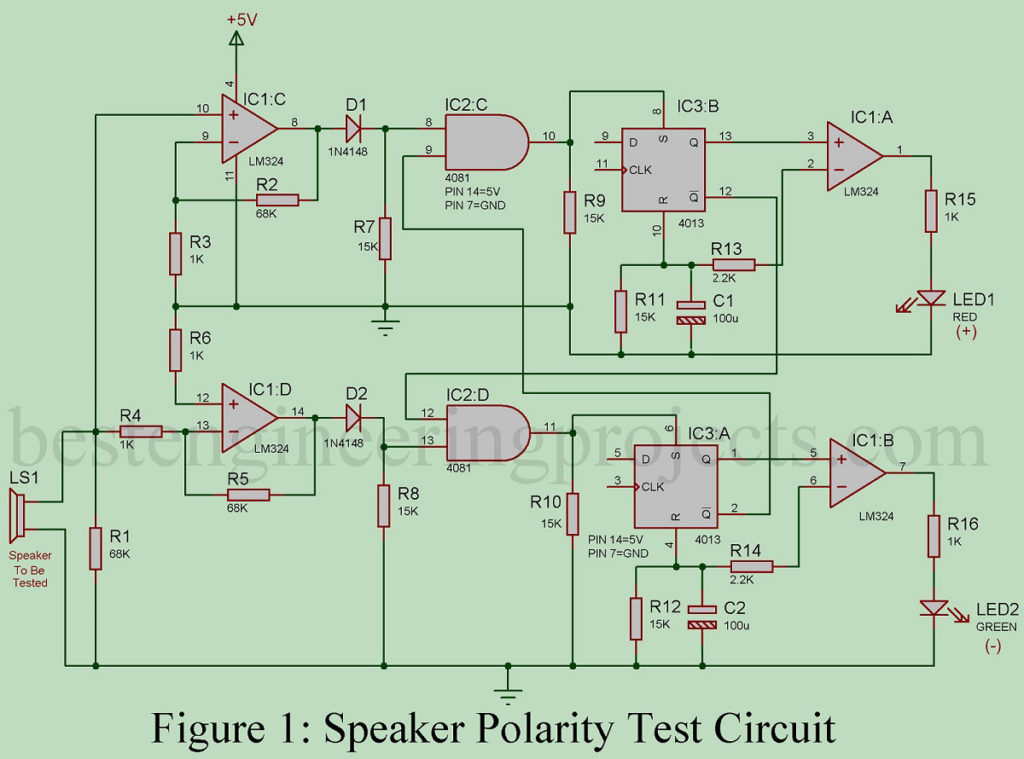These days, most BEP readers interested in Audio Engineering asked for a circuit that can recognize the polarity (positive and negative terminals) of the speaker. I had also experienced the problem of the polarity of speakers about a few years ago while testing one of my projects. At that time, I had used a multi-meter to test the polarity of the speaker.
While testing a multi-meter you have to concentrate on the movement of the speaker cone which is a difficult job especially for a small speaker. For the large speakers, there is also the problem of limiting current which may be very small for cone movement. There is various other problem like supplying DC voltage, tedious, time-consuming for mass production, etc.
In order to overcome this above problem, I came up with a simple circuit of speaker polarity test circuit with a flashing red and green LED for the unambiguous signal to the testing person (Figure 1). Not let’s talk about circuit description and its working procedure.
Description and Working of Speaker Test Circuit
Speaker is a transducer that converts an electrical signal to a sound signal. But according to Faraday’s law when we tap gently on a loudspeaker cone a signal is generated at its terminal which is sinusoidal in nature. The position (positive and negative) of the first half cycle of the signal generated decides the polarity of the speaker. Thus, the circuit given below is used to recognize the position (positive and negative) of the speaker.
There are two cases to identify the polarity of the speaker
- The first half cycle is positive: – The signal from the speaker is amplified by op-amp (IC1:C). The amplified output is given to one input of AND gate (IC2:C) whose another input is connected to pin 2, complement output of IC3: A. When the amplified output is high, the output of AND gate (IC2:C) also become high which SET flip-flop (IC3:B), results in LED1 flash once.
- The first half cycle is negative: – The entire procedure is the same as above for the positive half cycle. The signal is amplified by amplifier IC (IC1:D) followed by AND gate (IC2:D) and flip-flop IC (IC3:A), results in LED2 flash once.
R11 – C1 and R12 – R2 is the time constant components that reset flip-flip 1 (IC3:B) and flip-flip 2 (IC3:A) respectively. These combinations are responsible for the time duration of LEDs.
BEP NOTE: Labeling of LED (LED1 and LED2) for the positive and negative pin of loudspeaker depends on how the user defines the position of LEDs.
PARTS LIST OF SPEAKER POLARITY TEST CIRCUIT
| Resistor (all ¼-watt, ± 5% Carbon) |
| R1, R2, R5 = 68 KΩ
R3, R4, R6, R15, R16 = 1 KΩ R7 – R12 = 15 KΩ R13, R14 = 2.2 KΩ |
| Capacitors |
| C1, C2 = 100 µF/16V (Electrolytic Capacitor) |
| Semiconductors |
| IC1 = LM324 (quad operational amplifiers)
IC2 = CD4081 (quad 2-input AND Gate) IC3 = CD4013 (Dual D-Type Flip Flop) D1, D2 = 1N4148 (Small Signal Diode) |
| Miscellaneous |
| LED1 = 5mm Red LED
LED2 = 5mm Green LED LS1 = Speaker to be tested |
